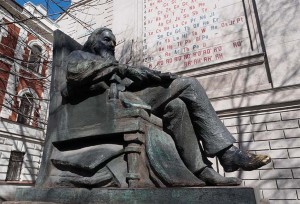The first element to be identified one atom at a time was named after the main architect of the modern periodic table. This seemingly straightforward etymological choice illustrates how scientific recognition can eclipse geopolitical tensions, says Anne Pichon.

A year to prepare a target, a week to make a new element, a couple of hours to detect it: the creation of element 101 was truly a race against time. By the middle of the 20th century, the University of California Radiation Laboratory, in Berkeley, was no stranger to the synthesis of transuranium elements. Neptunium was discovered there in 1940, as was plutonium. Investigations into nuclear processes as part of the Manhattan Project, analyses of the fallout from nuclear-weapon tests, and experiments using Ernest Lawrence’s cyclotron had led Berkeley scientists to discover elements 95 to 100, all between 1944 and 1952. These heavy atoms could be produced in a cyclotron by bombarding actinide targets with neutrons or α-particles.
In 1955, Glenn Seaborg, Albert Ghiorso and colleagues created 256101 by firing α-particles at 25399 nuclei (now known as einsteinium). Coming on the heels of several synthetic successes, it may seem to have been a fairly simple affair, but it wasn’t. It took a whole year to prepare enough 25399 to make a target — which then decayed within about a week. The team pioneered a ‘recoil’ technique that enabled target reuse, by providing the nuclei created with enough energy to leave the target and enter a ‘catcher’ foil. This was also an extremely low-yield synthesis: hours of bombardment produced a handful of atoms, which soon vanished (the half-life of 256101 is just 77 minutes).
A video from 1955 that casts some of the team conveys the excitement of this synthesis1. They raced from the cyclotron to the lab to analyse their sample, through chemical separations and by recording the radioactive decay of single atoms. On discovery day, 17 atoms of 256101 had been created. It was the first identification of a new element one atom at a time, yet also the last to use chemical processes2.
The new element was named after Dmitri Mendeleev, specifically because he had predicted the chemical properties of yet-unknown elements using their position in his classification system. The same principle had guided the discovery of the transuranium elements; indeed, these elements eluded identification until Seaborg correctly placed the actinide series on the periodic table. During the Cold War, however, honouring a Russian scientist in this manner was controversial. The name ‘mendelevium’ was carefully considered and ran past the US government before being proposed to, and ratified by, IUPAC in 1955 (with the symbol Mv, changed to Md two years later).
Mendeleev’s chemical legacy spans well beyond his crucial contribution to the development of the periodic table, even though some of his theories didn’t withstand the test of time quite so well; he was reluctant to accept the existence of the electron, focusing instead on understanding the universal ‘ether’3. Accounts of his life portray a man with socio-economic interests who passionately pursued many lines of enquiry. He foresaw the chemical value of petroleum, contributed to setting up women’s courses at St Petersburg University, and rode in a hot-air balloon, rather inadvertently on his own, to study a solar eclipse4. It thus seems fitting that beyond the chemical chart — sometimes referred to as ‘Mendeleev’s table’ — and its 101th tile, he also has an eponymous ridge in the Arctic Ocean and crater on the dark side of the moon.
Today, 17 isotopes of mendelevium are known; 258101, with its half-life of 51.5 days, is the least unstable. Relatively large quantities of lighter transuraniums can be formed in nuclear reactors by neutron capture followed by β– decay (conversion of a neutron into a proton), but this process cannot produce mendelevium because of the ‘fermium wall’ — isotopes of element 100 simply decay too quickly.
The resulting scarcity means that mendelevium has undergone few experimental investigations and has no practical use. It is known to adopt the +3 and +2 oxidation states in solution, and the fluoride and hydroxide species MdF3 and Md(OH)3 have been prepared together with their lanthanide homologues. Using one-atom-at-a-time techniques and relativistic calculations, the ionization potential of 251Md has also recently been measured5, along with those of 249Fm,257No and 256Lr. The trend found for these actinides mirrors that of the late lanthanides.
Back in Berkeley, as the elemental synthesis story continued to unfold, other protagonists joined Mendeleev on the periodic table: elements 103 and 106 now go by the respective names of lawrencium and seaborgium.
(원문: 여기를 클릭하세요~)